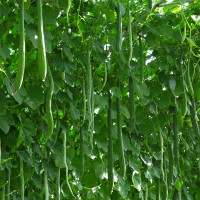Pepino, melon pear or sweet cucumber - is an evergreen shrub of the Solanaceae family. Cultivated for its edible sweet fruits, whose color and aroma resemble a mixture of melon, cucumber, pumpkin, or even pear flavor. As a perennial plant, it is grown in protected soil. Pepino is a perennial plant, which is a branched semi-lignified shrub, up to one and a half meters high, with tasty and aromatic fruits. Pepino is grown in the middle zone in heated greenhouses or as a house plant - on a windowsill, in a winter garden.
Pepino fruits are very diverse and differ from each other in size, shape, color and quality. Many of them have exotic coloring - a bright yellow background with jagged purple streaks. The pulp of a ripe fruit is yellow or colorless. The taste is sweet and sour and very juicy, as it consists of 92% water. The sourness of this fruit is due to the vitamin C it contains. Pepino is rich in keratin, iron and pectin substances, a large amount of vitamins A, B1, B2 and PP. The flowers of the new vegetable crop are most similar to potato flowers. Stem and leaves like pepper.
The pepino fruit is a berry, the shape of the fruit is elongated-conical or flat-round, 15-17 cm long, 10-12 cm wide, with an average weight of 600 grams. At the stalk, the surface of the fruit is slightly depressed, which gives it a heart-shaped shape. At the stage of full maturity, the fruits are cream-colored with many longitudinal purple stripes, the flesh is yellow, very juicy and tasty. Pepino fruits perfectly quench thirst.
Growing pepino from seeds
Pepino is propagated by seeds and cuttings. They are germinated on moistened paper napkins, covered with transparent bags, in the dark at a temperature of 26-28 degrees. The hatched seeds are transferred to a warm, bright place. When the cotyledons open, the seedlings dive. But the easiest way to propagate melon pear is by rooting cuttings. They take root well and begin to bear fruit earlier. Caring for seedlings is the same as caring for eggplants. Seedlings from seeds are illuminated for 16-18 hours until the end of February. Seedlings are planted in a heated greenhouse from the end of March - 3 plants per 1 sq.m. Once a week it is fed with complex fertilizers. Foliar feeding with diluted whey (1:10) with a solution of microelements is useful. Formation usually occurs in one stem. In order for the fruit to set, the plants need to be shaken slightly.
Plants form 1-2 stems, the agricultural technology of growing seedlings is close to eggplant, and after planting in a permanent place - to tomato. Unripe fruits are used fresh as one of the components of vegetable salads or pickled (when pickled, they can be compared to cucumbers in taste). Ripe fruits are used for fresh consumption, making jam or candied fruits, and are also dried and frozen.
The fruits ripen at different times: when they become the size of a goose egg and acquire a cream or pale yellow color, they are picked. An overripe melon pear becomes tasteless. Ripe fruits can be stored for several months at a temperature of 4-5 degrees.
Residents of Japan prepare fruit salads and desserts from pepino. In New Zealand, it is used to prepare soups, sauces, and served with meat, fish and seafood. In addition, it can be salted, canned, dried, frozen, made into jam, jams and compotes.
Pepino fruits are rich in vitamins A, PP, group B, iron and high iodine content, so they are especially indicated for people with thyroid diseases. The low acidity of the fruit has a beneficial effect when consumed by people suffering from high acidity of the gastrointestinal tract.

No questions about this product, be the first and ask your question.























